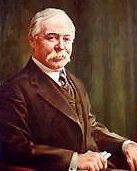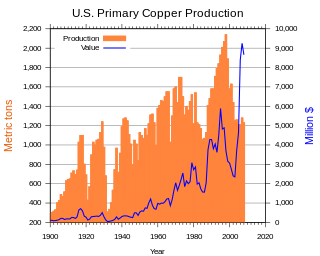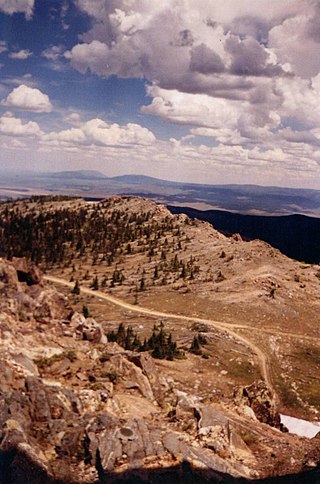
Encampment is a town in southern Carbon County, Wyoming, United States. The population was 450 at the 2010 census.

Marcus Daly was an Irish-born American businessman known as one of the three "Copper Kings" of Butte, Montana, United States.

Kennecott, also known as Kennicott and Kennecott Mines, is an abandoned mining camp in the Copper River Census Area in the U.S. state of Alaska that was the center of activity for several copper mines. It is located beside the Kennicott Glacier, northeast of Valdez, inside Wrangell-St. Elias National Park and Preserve. The camp and mines are now a National Historic Landmark District administered by the National Park Service.

In the United States, copper mining has been a major industry since the rise of the northern Michigan copper district in the 1840s. In 2017, the US produced 1.27 million metric tonnes of copper, worth $8 billion, making it the world's fourth largest copper producer, after Chile, China, and Peru. Copper was produced from 23 mines in the US. Top copper producing states in 2014 were Arizona, Utah, New Mexico, Nevada, and Montana. Minor production also came from Idaho, and Missouri. As of 2014, the US had 45 million tonnes of known remaining reserves of copper, the fifth largest known copper reserves in the world, after Chile, Australia, Peru, and Mexico.

The Shenandoah-Dives Mill or Mayflower Mill is an intact and functional but inactive historic ore mill 2 miles (3.2 km) east of Silverton, Colorado, United States. The mill was built in 1929 to recover gold, silver, lead, zinc, and copper from ore mined at the Mayflower mine and brought to the mill by an aerial tramway. Regularly active until 1945, it houses still-functional equipment for the separation by flotation of metals from crushed ores. It is the only intact and functional mill of its kind in Colorado. It was included in the expanded Silverton Historic District in 1997, and was declared a National Historic Landmark on its own in 2000. The mill is owned by the San Juan County Historic Society, which staffs an information and gift shop at the mill under the name Mayflower Mill. The mill is open for self-guided tours in the summer months.

Bristol Wells, also known as National City, Bristol City and Tempest, is a ghost town in Lincoln County, Nevada. The mining town was located on the west side of Bristol Mountain, 14 miles (23 km) northwest of Pioche, Nevada.

The Johnson Lake Mine is a former tungsten mine located within the boundaries of Great Basin National Park in eastern Nevada. Located on the east slope of the southern Snake Range at an elevation above 10,000 ft (3,000 m), the 100 acres (40 ha) historic district was listed on the National Register of Historic Places in 1995.

The Sierra Madre Range is a mountain range in the western United States, located in south-central Wyoming and north-central Colorado. Geologically, it may be considered an extension of the Park Range of Colorado. South of the Great Divide Basin, the US Continental Divide runs along the Sierre Madre high points. Its western basins drain into the Colorado River and its eastern into the North Platte River. Buck Mountain is the highest peak in the range and lies within Colorado. Bridger Peak is its highest elevation on the Wyoming side of the range.

The Knight–Mangum House is a historic house located in Provo, Utah, United States. It is listed on the National Register of Historic Places. The mansion was built in the old English Tudor style, completed in 1908. It was built for Mr. W. Lester Mangum and his wife Jennie Knight Mangum. Mrs. Mangum was the daughter of the famous Utah mining man, Jesse Knight. The lot was purchased for $3,500 and the home was built at a cost of about $40,000. The Mangum family was able to afford the home due to the fact that they had sold their shares in Jesse Knight's mine located in Tintic, Utah, for eight dollars a share. They had purchased the shares for only twenty cents a share, so the excess allowed them enough funds to purchase the home. The contractors for the home were the Alexandis Brothers of Provo.

The John R. Twelves House is a historic house located in Provo, Utah, United States. It is listed on the National Register of Historic Places.

Sunrise was a company mining town of the Colorado Fuel and Iron Company located in Platte County, Wyoming, United States. The entire site of the former mining district and town is listed on the National Register of Historic Places.

The George Ferris Mansion in Rawlins, Wyoming is one of the most significant Queen Anne style buildings in Wyoming. Built during 1899–1903, the house's design was published by the Knoxville, Tennessee architectural firm of Barber and Klutz in an architectural pattern book. The house was built for George and Julia Ferris.
White Knob, Idaho is a ghost town in Custer County, Idaho. It is situated on Mine Hill between the town of Mackay, Idaho and the White Knob Mountains in the Pioneer Mountains.

The Boston Wyoming Smelter Site was the site of a copper smelter that processed ores from the nearby Grand Encampment Mining District in Carbon County, Wyoming in the early 20th century. The site includes the former town of Rudefeha and is near Encampment, Wyoming. The smelter was constructed in 1902 by Grand Encampment promoter Willis George Emerson, connected to the main Ferris-Haggerty Mine location by a 16-mile (26 km) aerial tram over the Continental Divide. The smelter initially produced matte, an intermediate product in copper refining. In 1903 it was upgraded to produce blister copper. Power for the blowers needed for the blister refining process came from a water turbine at the end of a 4-foot (1.2 m) diameter wood-stave pipe from the South Fork of the Encampment River, 4 miles (6.4 km) away. The smelter could process 300 to 400 tons of ore a day.

The Rawlins Residential Historic District abuts the north and east sides of the commercial district of Rawlins, Wyoming. United States. The area covers 15 blocks of small houses built between 1880 and 1915 in a variety of styles. The area was part of Union Pacific Railway property that was incorporated into Rawlins. One defining feature of the houses is a consistent use of locally quarried stone in foundations and landscape walls. Apart from the houses, St. Joseph's Catholic Church is also within the district. Styles include Queen Anne, cottage and bungalow style architecture.

The Willis House is a historic residence in Encampment, Wyoming, United States, that is listed on the National Register of Historic Places.

The Britannia Mines Concentrator is a National Historic Site of Canada. The large, inclined gravity mill was built on the northwest side of Mount Sheer to assist the transfer of copper ore through the chemical and mechanical processes of the plant. It is a landmark in Britannia Beach, British Columbia some forty-five kilometers north of Vancouver.

The Saline Valley salt tram is located in Inyo County, California, United States. The electric aerial tramway was constructed from 1911 to 1913 to carry salt from the Saline Valley over the Inyo Mountains and into the Owens Valley. Covering a distance of 13.4 mi (21.6 km), it operated sporadically from 1913 to 1935 for four different companies. During its operation, it was the steepest tram in the United States.

















